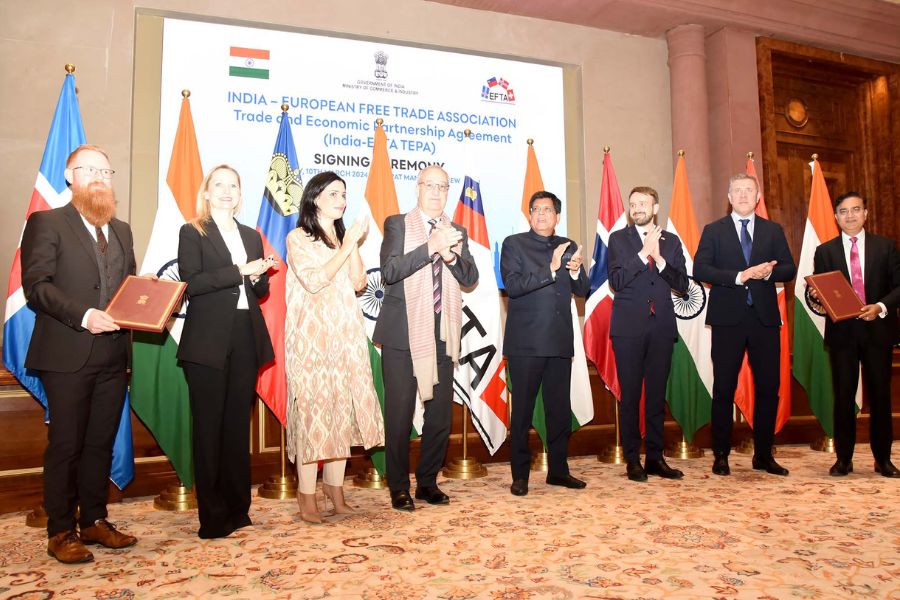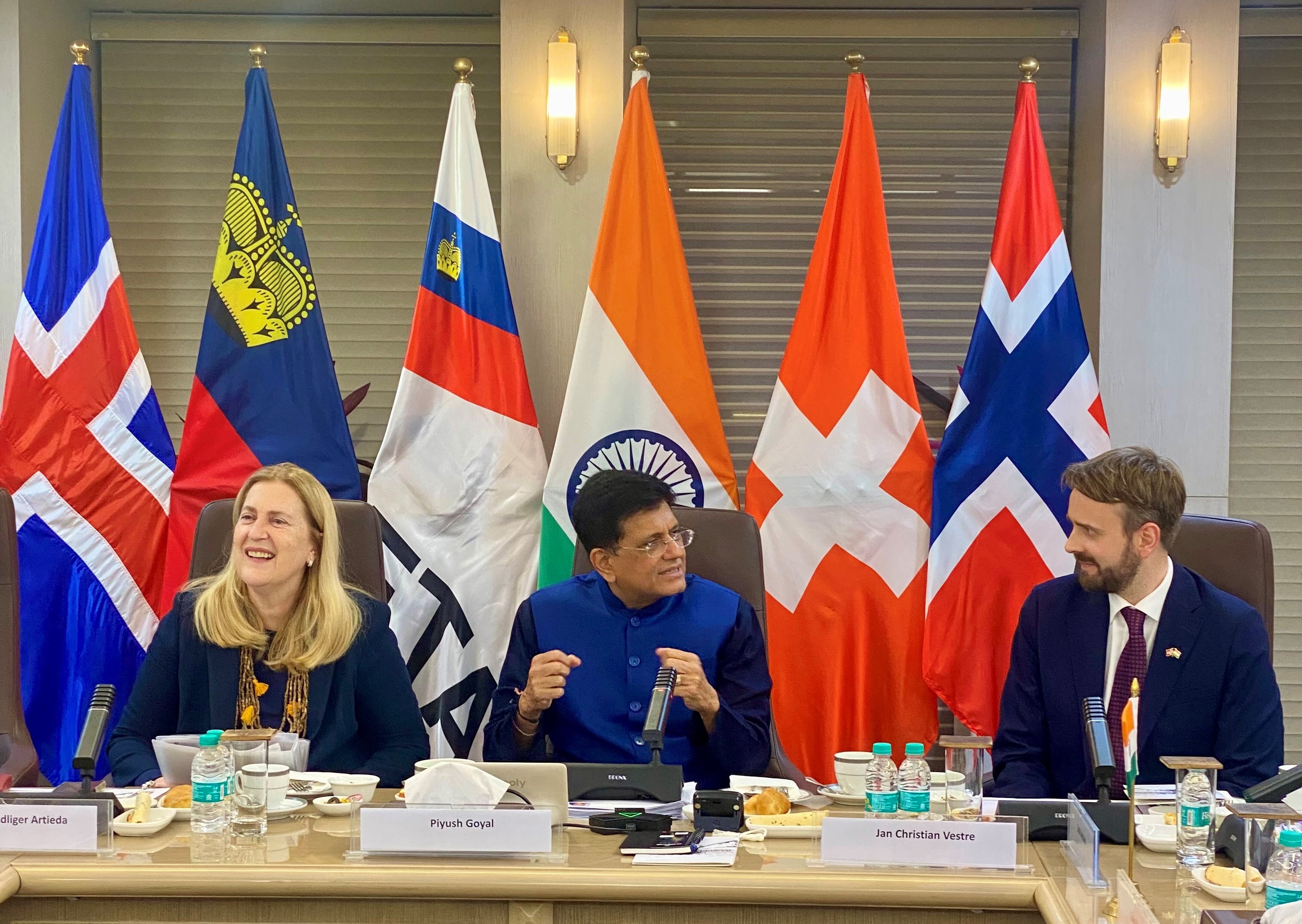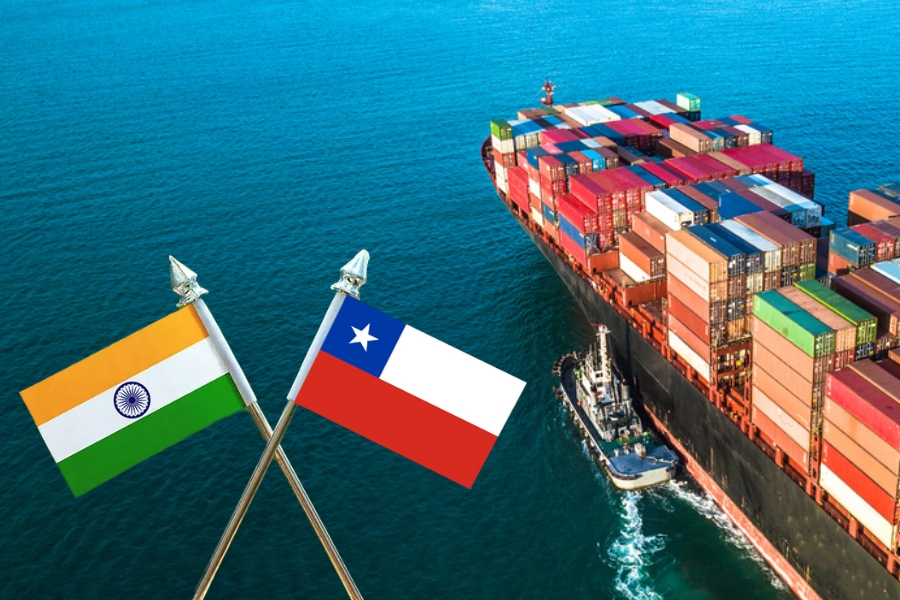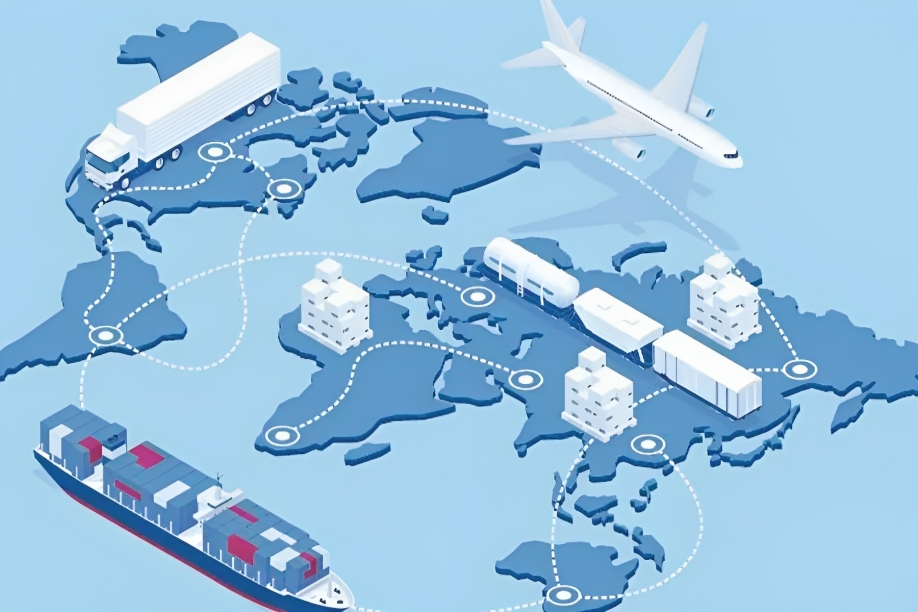Central and East Europe: The unexplored facet of EU
From non-alignment to multi-alignment, India’s ties with Central and East Europe have come a long way. Yet a closer look at their trade ties depicts that they have a tremendous untapped trade potential. Concluding an India-EU FTA can go a long way in improving bilateral trade through resolution of tariff and non-tariff barriers.
- CEE is becoming an increasingly pivotal region for India. Political relations strengthened during the Cold War period, led in part by India’s relations with erstwhile USSR, and economic ties also developed thereafter.
- The CEE region is flourishing with niche capabilities in technology, defense, and IT sectors, thereby attracting India. Further, the Visegrád Group, also known as the V4 countries (Czech Republic, Poland, Hungary, Slovakia) has emerged among the fastest growing economies in the European Union in the 21st century.
- Yet, India-Central and East Europe trade is meager. India accounted for just 0.04% of CEE’s total imports, while CEE accounts for merely 1.1% of India’s imports. This reveals that there exists tremendous untapped trade potential between them.
- Signing an FTA that addresses trade barriers can be a major game-changer for the bilateral trade in products as well as services.

Image credit: Poland Tourism Organisation
The Central and East Europe region comprises Albania, Bulgaria, Croatia, the Czech Republic, Hungary, Poland, Romania, the Slovak Republic, Slovenia, and the three Baltic States of Estonia, Latvia and Lithuania according to the OECD. It is becoming an increasingly pivotal region for India. History indicates a strong fascination in CEE countries for Indian religion and culture. Political relations strengthened during the Cold War period, led in part by India’s relations with erstwhile USSR, and economic ties also developed thereafter.
In the more recent past, during President Ram Nath Kovind’s 2018 visit to the region, he urged CEE countries to support India’s “Make in India” initiative and India reached out to Europe with its vaccine diplomacy. Between September 2-5, 2021, India’s External Affairs Minister, Dr. S. Jaishankar, paid an official visit to Slovenia and Croatia.
Central and Eastern Europe is important for India as it offers foreign companies access to the European Union’s markets but with lower operational costs than Western part of Europe. The CEE region is flourishing with niche capabilities in technology, defense, and IT sectors, thereby attracting India. Further, the Visegrád Group, also known as the V4 countries (Czech Republic, Poland, Hungary, Slovakia) has emerged among the fastest growing economies in the European Union in the 21st century. At the same time, despite the pandemic, India is one of the brightest spots in South Asia, with its economy expected to grow by 7.2% in 2021, as per the latest UN projections, making it a key potential partner for CEE countries. This blog delves into mutual synergies between the two countries and the prospects for meaningful engagement.
India-Central and East Europe: Trade prospects
India has a tremendous untapped export potential to CEE. For example, India’s total exports of medium oils and preparations, of petroleum or bituminous minerals, not containing biodiesel, n.e.s. to the world currently stand at US$ 17.6 billion (2020). However, its exports to CEE in 2020 for this product amounted to US$ 3.64 million or just 0.04% of CEE’s total imports. In comparison, CEE imports medium oils worth US$ 9.3 billion from other countries, especially, Russia, Germany & Belarus.
Potential export products for India to the CEE region
| Product categories | India’s exports to CEE (US$ mn) in 2020 | CEE’s imports from world (US$ mn) in 2020 | India’s exports to world in 2020 (US$ mn) | India’s share in CEE’s imports (%) | Competitors |
| Medium oils and preparations, of petroleum or bituminous minerals, not containing biodiesel, n.e.s. | 3.6 | 9,269.3 | 9.3 | 0.0 | Russia, Germany, Belarus |
| Motor cars and other motor vehicles principally designed for the transport of persons | 1.3 | 5,247.9 | 5.2 | 0.0 | Germany, Czech Republic, Spain |
| Light oils and preparations, of petroleum or bituminous minerals | 0.0 | 2,403.3 | 2.4 | 0.0 | Austria, Belarus, Russia |
| Motor cars and other motor vehicles principally designed for the transport of persons, incl. station wagons and racing cars, | 0.2 | 1,797.7 | 1.8 | 0.0 | Czech Republic, Romania, Germany |
| T-shirts, singlets and other vests of cotton | 38.3 | 1,719.2 | 1.7 | 2.2 | Bangladesh, Germany, Turkey |
| Herbicides, anti-sprouting products and plant-growth regulators | 8.5 | 1,464.8 | 1.5 | 0.6 | France, Germany, Israel |
| Non-agglomerated iron ores and concentrates | 0.0 | 1,309.4 | 1.3 | 0.0 | US, Russia, Turkey |
| Medicaments containing antibiotics, put up in measured doses | 36.3 | 795.2 | 0.8 | 4.6 | Italy, France Germany |
Source: ITC Trade Map
Meanwhile, CEE’s exports crude sunflower seed/oil, urea, coke & semi-coke of coal, spark ignition piston engine, oilcakes, gas turbines, and electrodes of graphite to India. The CEE region accounts for only 1.1% of India’s imports. Thus, CEE, too, can enhance its exports to India, given the latter’s huge market and desire to be a manufacturing hub. There exists great opportunity in the case of urea, for example. India imported urea worth US$ 2.9 billion in 2020 from the world, of which CEE constituted 8.5% (US$ 248.17 million). The CEE region exports urea amounting US$ 892.5 million to the world. China, Oman & Egypt are its key competitors in this field.
Potential export products for CEE region to India
| Product categories | India’s imports from CEE (in US$mn) in 2020 | India’s imports from world (in US$ mn) in 2020 | CEE’s exports to world in 2020 (in US$ mn) | CEEs share in India’s imports (%) | Competitors |
| Crude sunflower-seed or safflower oil | 1,587.56 | 2,072.76 | 5,513.61 | 76.6 | China, Oman, Egypt |
| Urea, whether or not in aqueous solution | 248.17 | 2936.68 | 892.57 | 8.5 | China, Oman, Egypt |
| Coke and semi-coke of coal, of lignite or of peat | 225.10 | 625.04 | 1,619.44 | 36.0 | Poland, Japan, Colombia |
| Potassium chloride for use as fertiliser | 121.16 | 1259.33 | 42.12 | 9.6 | Canada, Belarus, Russia |
| Commodities not elsewhere specified | 114.34 | 1,881.35 | 7,616.97 | 6.1 | Russia, China, Germany |
| Anhydrous ammonia | 73.69 | 636.99 | 110.23 | 11.6 | Iraq, UAE, Republic of Korea |
| Medium oils and preparations, of petroleum or bituminous minerals, | 50.76 | 4,772.08 | 4,071.03 | 1.1 | Iraq, UAE, Republic of Korea |
| Polyvinyl chloride”, in primary forms, not mixed with any other substances | 44.72 | 1,417.10 | 513.82 | 3.2 | Japan, Taipei, Republic of Korea |
| Aeroplanes and other powered aircraft of an of an unladen weight > 15000 kg | 43.81 | 1,113.83 | 301.21 | 3.9 | Kuwait, Latvia, Bangladesh |
| Spark-ignition reciprocating piston engine | 41.07 | 43.63 | 1,116.24 | 94.1 | Czech Republic, Romania, China |
Source: ITC Trade Map
Overcoming trade barriers:
Indian exporters face quite a few tariff barriers while engaging with CEE countries. For example, the tariff structure of CEE varies between 2.87% in Hungary to 5.32% in Slovakia according to WITS. India, on the contrary, imposes tariffs ranging between 5.36% on Latvia to 78.69% Ukraine. This enhances export costs and makes companies uncompetitive.
| Tariff Structure of CEE countries | |
| Country | Applied Weighted Average (%) tariff imposed on India |
| Poland | 5.32 |
| Czech Republic | 4.82 |
| Hungary | 2.87 |
| Ukraine | 2.39 |
| Romania | 3.34 |
| Bulgaria | 4.18 |
| Lithuania | 4.49 |
| Latvia | 3.87 |
| Estonia | 4.7 |
Source: WITS, 2019
Earlier this year, Minister of State for Textiles, Darshana Jardosh, noted that India’s textiles exports in 2020 stood at US$ 29.61 billion, while the shipments of Bangladesh, Vietnam, and Cambodia in that year were US$ 37.95 billion, US$ 37.10 billion and US$ 7.77 billion respectively. She added:
High tariffs faced by Indian exporters in key markets such as the EU and the UK as compared to zero duty access given to competing nations like Bangladesh and Cambodia are affecting India’s exports performance.
Moreover, advanced regions like the EU are known to keep much higher NTBs. For example, some time back, in 2010, the EU rejected table grapes consignments from India, leading to a sudden slowdown in the industry. Then in August 2014, the EU introduced “specific conditions” on the import of okra and curry leaves from India and in 2015, it again rejected consignments citing traces of chlormequat chloride, a plant growth regulator – leading to losses of about Rs 300 crore. More recently in January 2018, the EU also rejected imports of rice with levels of tricyclazole.
FTA: The ray of hope for India-CEE trade ties?
India and the EU are set to negotiate the prospects of a possible Free Trade Agreement after a hiatus of 8 years. After 16 rounds of talks between 2007 and 2013, formal negotiations for the FTA came to a halt. This is because the EU insisted that India scrap or slash hefty import duties on sensitive products such as automobiles, alcoholic beverages and cheese, among others while India’s demands included greater access to the EU market for its skilled professionals and lowering of NTBs. Both the parties were reluctant to concede to each other’s demands.
Concluding a deal with the EU will also be pivotal for enhancing engagement between India and CEE nations. Amb Anil Trigunayat, Former Ambassador of India to Jordan, Libya and Malta and President, MIICCIA Chamber of Commerce opines:
India-EU relations are getting more important also from the bilateral perspective (India with specific EU member states). The proposal for a comprehensive connectivity partnership is a low hanging fruit that the both sides can explore. It creates a lot of opportunities for businesses across industries.
Both the CEE and India may benefit through resolution of the following SPS issues: ensuring the protection of human, animal or plant life or health, without imposing unjustified barriers to trade; strengthening transparency and exchange of information in the sphere of development and application of SPS measures; establishment of a bilateral dialogue on SPS issues and a mechanism to address specific SPS issues; and promotion of cooperation between responsible authorities and increase of mutual understanding of SPS regulatory systems.
In addition to this, the FTA can help in the reduction of tariffs by the two regions. This will increase trade in agricultural products (crops, vegetable oils, food preparation products, vegetables, beverages, including mineral water); and for industrial products (fertilizers, machinery and equipment, motor vehicles, some types of turbojets, salt, steel products, chemical, rubber, plastic, including polyimides, wood products).
The trade in goods which is expected to grow as a result of the FTA can also go a long way in benefiting bilateral services trade, due to the necessity of “trade-enabling” services such as transport services, insurance, and banking services, telecommunication services and distribution services. Moreover, an FTA in services could further strengthen sectors already dominant in the bilateral trade – such as travel services, computer & related services, other business and professional services. Areas of strong complementarity such as hi-tech research and development, tourism, engineering services, environmental and agricultural services, energy, academic studies, etc, in particular, can benefit.













Leave a comment